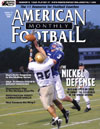AMERICAN FOOTBALL MONTHLY THE #1 RESOURCE FOR FOOTBALL COACHES
Article CategoriesAFM Magazine
|
The Speed Report: Variables For In-Season Speed Training (Part 2)by: Dale BaskettFootball Speed Specialist © More from this issue Last month we described many things that you can accomplish and sustain during the in-season. So very often in-season speed training becomes a burden to the football world in terms of time allotment. Football is about speed and the maintenance of technical applications that produce it. It never ceases to amaze me how much can be accomplished during the season with consistent training reinforcement. Conversely, the dissipation of technique can also be void of consistency when neglected. Coaches: please address speed in-season the same as you would off-season. The focus should be on quality and not quantity. Every time I present a clinic/ workshop for high school coaches, we always get into a debate about how much is too much. As expressed many times before, the quantity of running and speed training is never the objective. Itâ€....The full article can only be seen by subscribers. Subscribe today!
|
|
|||||||
| HOME |
MAGAZINE |
SUBSCRIBE | ONLINE COLUMNISTS | COACHING VIDEOS |
Copyright 2026, AmericanFootballMonthly.com
All Rights Reserved





